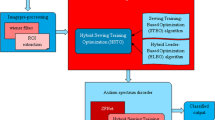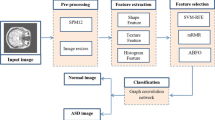Abstract
Autism spectrum disorder (ASD) is one of the major problems, which manifests at a young age and is hard to identify in the early stages. Typically, it affects the interaction skills and social behavior in children aged 6–17 years old. Autism is caused by both genetic and environmental factors. Autism can manifest itself in children as a lack of communication, social interaction, and limited interest behaviors, among other symptoms. ASD is a mild retardation, in which many people on ASD have incredible talents and abilities. Approximately 40% are academically above average and possess a special ability to view the world with joy from a unique viewpoint. This paper developed the ASD classification using deep Q learning network (DQN), and SpinalNet, wherein these network’s hyperparameters are trained by the proposed driving training political optimizer (DTPO). The initial stage of this processing starts with the acquisition of an image from the dataset, and further preprocessing is carried out by an adaptive Wiener filter, and this filtered image is sent to regions of interest (ROI) extraction. After that, extraction of the nub region is done by the proposed DTPO, from which the classification process is done by considering extracted features. Moreover, the classification performance of ASD is performed, and the output of DQN and SpinalNet is subjected to a fusion process to provide the classification of ASD with the help of Czekanowski similarity. Furthermore, the classification is based on three metrics like accuracy, sensitivity, specificity, mean-squared error, root-mean-squared error, R, and mean absolute error, with superior values of 0.907, 0.958, 0.936, 0.536, 0.732, 0.488, and 0.409, respectively.


Similar content being viewed by others
Data availability
In case of benchmark data The data taken for this work are available in autism brain imaging data exchange (ABIDE)dataset, is taken from “https://github.com/lsa-pucrs/acerta-abide”.
References
Subah, F.Z., Deb, K., Dhar, P.K., Koshiba, T.: A deep learning approach to predict autism spectrum disorder using multisite resting-state fMRI. Appl. Sci. 11(8), 3636 (2021)
Sewani, H., Kashef, R.: An autoencoder-based deep learning classifier for efficient diagnosis of autism. Children 7(10), 182 (2020)
Goel, N., Grover, B., Gupta, D., Khanna, A., Sharma, M.: Modified grasshopper optimization algorithm for detection of autism spectrum disorder. Phys. Commun. 41, 101115 (2020)
Sherkatghanad, Z., Akhondzadeh, M., Salari, S., Zomorodi-Moghadam, M., Abdar, M., Acharya, U.R., Khosrowabadi, R., Salari, V.: Automated detection of autism spectrum disorder using a convolutional neural network. Front. Neurosci. 13, 1325 (2020)
Ke, F., Choi, S., Kang, Y.H., Cheon, K.A., Lee, S.W.: Exploring the structural and strategic bases of autism spectrum disorders with deep learning. IEEE Access 8, 153341–153352 (2020)
Moridian, P., Ghassemi, N., Jafari, M., Salloum-Asfar, S., Sadeghi, D., Khodatars, M., Shoeibi, A., Khosravi, A., Ling, S.H., Subasi, A., Abdulla, S.A.: Automatic autism spectrum disorder detection using artificial intelligence methods with MRI neuroimaging: a review (2022). arXiv preprint https://arxiv.org/abs/2206.11233
Tang, M.C.S., Teoh, S.S., Ibrahim, H.: Retinal vessel segmentation from fundus images using DeepLabv3+. In: 2022 IEEE 18th International Colloquium on Signal Processing and Applications (CSPA), pp. 377–381 (2022)
Tang, M.C.S., Teoh, S.S.: Blood vessel segmentation in fundus images using Hessian matrix for diabetic retinopathy detection. In: 2020 11th IEEE Annual Information Technology, Electronics and Mobile Communication Conference (IEMCON), pp. 0728–0733 (2020)
Khodatars, M., Shoeibi, A., Sadeghi, D., Ghaasemi, N., Jafari, M., Moridian, P., Khadem, A., Alizadehsani, R., Zare, A., Kong, Y., Khosravi, A.: Deep learning for neuroimaging-based diagnosis and rehabilitation of autism spectrum disorder: a review. Comput. Biol. Med. 139, 104949 (2021)
Ahmed, M.R., Zhang, Y., Liu, Y., Liao, H.: Single volume image generator and deep learning-based ASD classification. IEEE J. Biomed. Health Inform. 24(11), 3044–3054 (2020)
Tang, M.C.S., Teoh, S.S., Ibrahim, H., Embong, Z.: Neovascularization detection and localization in fundus images using deep learning. Sensors 21(16), 5327 (2021)
Tang, M.C.S., Teoh, S.S., Ibrahim, H., Embong, Z.: A deep learning approach for the detection of neovascularization in fundus images using transfer learning. IEEE Access 10, 20247–20258 (2022)
Shao, L., Fu, C., You, Y., Fu, D.: Classification of ASD based on fMRI data with deep learning. Cogn. Neurodyn. 15(6), 961–974 (2021)
Eslami, T., Saeed, F.: Auto-ASD-network: a technique based on deep learning and support vector machines for diagnosing autism spectrum disorder using fMRI data. In: Proceedings of the 10th ACM International Conference on Bioinformatics, Computational Biology and Health Informatics, pp. 646–651 (2019)
Sokol, D.K., Edwards-Brown, M.: Neuroimaging in autistic spectrum disorder (ASD). J. Neuroimaging 14(1), 8–15 (2004)
Xie, J., Wang, L., Webster, P., Yao, Y., Sun, J., Wang, S., Zhou, H.: A two-stream end-to-end deep learning network for recognizing atypical visual attention in autism spectrum disorder (2019). arXiv preprint https://arxiv.org/abs1911.11393
Saranya, A., Anandan, R.: FIGS-DEAF: an novel implementation of hybrid deep learning algorithm to predict autism spectrum disorders using facial fused gait features. Distrib. Parallel Databases 40, 1–26 (2021)
Autism Brain Imaging Data Exchange (ABIDE). Taken from https://github.com/lsa-pucrs/acerta-abide. Accessed Jan 2023.
Jin, F., Fieguth, P., Winger, L., Jernigan, E.: Adaptive Wiener filtering of noisy images and image sequences. In: Proceedings of 2003 International Conference on Image Processing (Cat. No. 03CH37429), vol. 3, pp. III-349. IEEE (2003)
Dehghani, M., Trojovská, E., Trojovský, P.: Driving training-based optimization: a new human-based metaheuristic algorithm for solving optimization problems (2022)
Askari, Q., Younas, I., Saeed, M.: Political optimizer: a novel socio-inspired meta-heuristic for global optimization. Knowl. Based Syst. 195, 105709 (2020)
Cristin, D.R., Kumar, D.K.S., Anbhazhagan, D.P.: Severity level classification of brain tumor based on MRI images using fractional-chicken swarm optimization algorithm. Comput. J. 64(10), 1514–1530 (2021)
Gu, J., Liu, C.: Feature local binary patterns with application to eye detection. Neurocomputing 113, 138–152 (2013)
Guo, Z., Zhang, L., Zhang, D.: A completed modeling of local binary pattern operator for texture classification. IEEE Trans. Image Process. 19(6), 1657–1663 (2010)
Liu, C., Wechsler, H.: A Gabor feature classifier for face recognition. In: Proceedings of Eighth IEEE International Conference on Computer Vision, ICCV 2001, vol. 2, pp. 270–275. IEEE (2001)
Feigang, T.: SLBP: an improved texture feature for pedestrian detection. In: Proceedings of 2017 International Conference on Smart City and Systems Engineering (ICSCSE), pp. 202–204. IEEE (2017)
Sasaki, H., Horiuchi, T., Kato, S.: A study on vision-based mobile robot learning by deep Q-network. In: Proceedings of 2017 56th Annual Conference of the Society of Instrument and Control Engineers of Japan (SICE), pp. 799–804. IEEE (2017)
Kabir, H.D., Abdar, M., Khosravi, A., Jalali, S.M.J., Atiya, A.F., Nahavandi, S., Srinivasan, D.: Spinalnet: Deep neural network with gradual input. IEEE Trans. Artif. Intell. (2022). https://doi.org/10.1109/TAI.2022.3185179
Somerfield, P.J.: Identification of the Bray-Curtis similarity index: comment on Yoshioka. Mar. Ecol. Prog. Ser. 372, 303–306 (2008)
Acknowledgements
I would like to express my very great appreciation to the co-authors of this manuscript for their valuable and constructive suggestions during the planning and development of this research work.
Funding
This research did not receive any specific funding.
Author information
Authors and Affiliations
Contributions
All authors have made substantial contributions to conception and design, revising the manuscript, and the final approval of the version to be published. Also, all authors agreed to be accountable for all aspects of the work in ensuring that questions related to the accuracy or integrity of any part of the work are appropriately investigated and resolved. SU conceived the presented idea and designed the analysis. Also, he carried out the experiment and wrote the manuscript with support from RMP,ESGSR and CP. All authors discussed the results and contributed to the final manuscript. All authors read and approved the final manuscript.
Corresponding author
Ethics declarations
Conflict of interest
The authors declare no conflict of interest.
Ethical approval
Not applicable.
Informed consent
Not applicable.
Additional information
Publisher's Note
Springer Nature remains neutral with regard to jurisdictional claims in published maps and institutional affiliations.
Rights and permissions
Springer Nature or its licensor (e.g. a society or other partner) holds exclusive rights to this article under a publishing agreement with the author(s) or other rightsholder(s); author self-archiving of the accepted manuscript version of this article is solely governed by the terms of such publishing agreement and applicable law.
About this article
Cite this article
Ulaganathan, S., Ramkumar, M.P., Emil Selvan, G.S.R. et al. Spinalnet-deep Q network with hybrid optimization for detecting autism spectrum disorder. SIViP 17, 4305–4317 (2023). https://doi.org/10.1007/s11760-023-02663-3
Received:
Revised:
Accepted:
Published:
Issue Date:
DOI: https://doi.org/10.1007/s11760-023-02663-3




